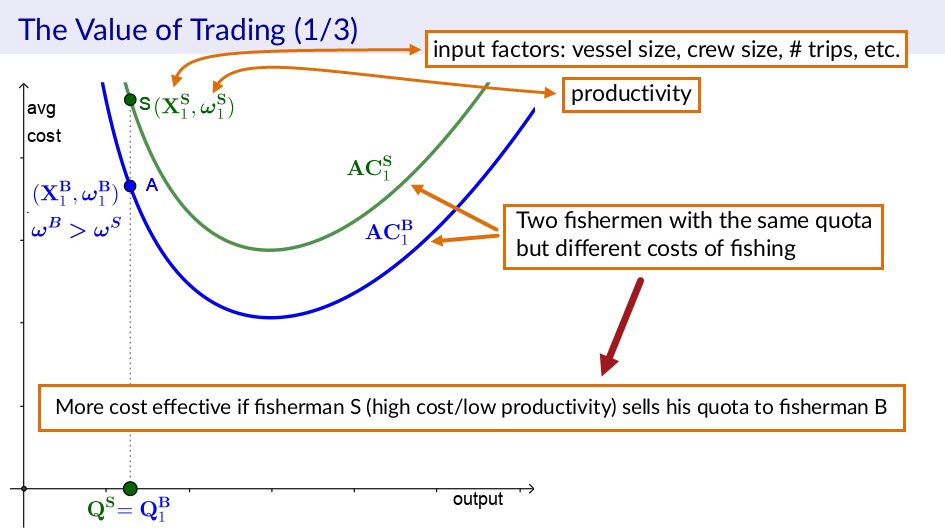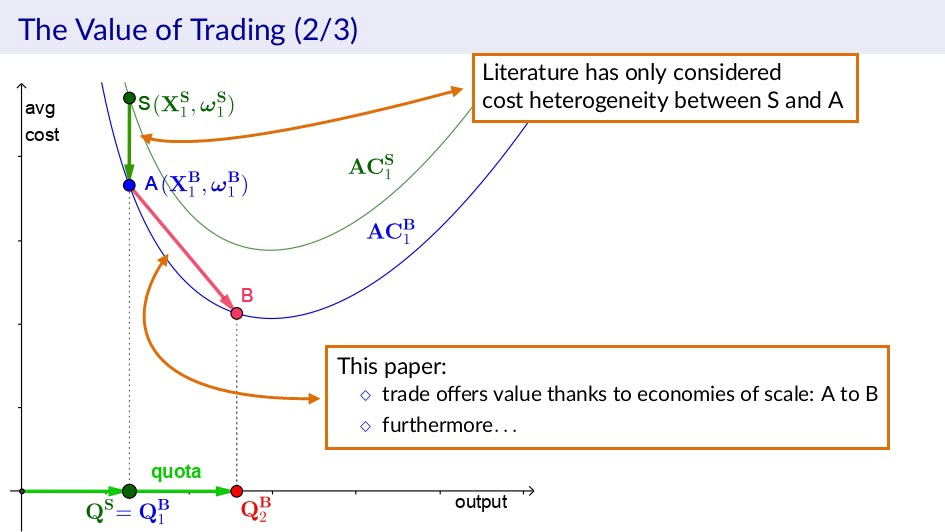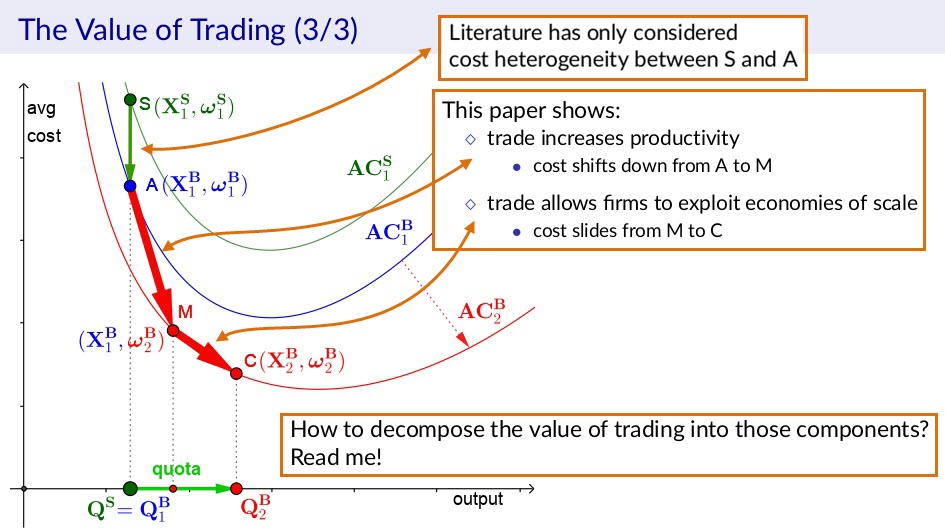RESEARCH
RESEARCH INTERESTS
Environmental & Resource Economics, Industrial Organization, Applied Econometrics
PUBLICATIONS
[5] Lessons for Regulating Flaring and Venting: Results from Alberta, Canada,
Energy Policy, 206:114774, 2025, with Adrian Guerin,
Nouri Najjar, and Brandon Schaufele.
[Ungated Version].
Abstract
Regulating methane from the upstream oil and gas sector is seen as a low-cost method to reduce emissions. Yet, there is surprisingly little work studying the economic dynamics of flaring and venting, key sources of these emissions. We analyze data from Alberta, Canada, a jurisdiction that has regulated flaring and venting for more than two decades. We present five lessons for policy-makers. Paramount among these is that flaring and venting are each subject to different regulatory challenges, and thus require distinct regulatory approaches. The key to mitigating flaring is to encourage crude oil extractors to capture associated gases. The key to mitigating venting is to promote the development and adoption of alternative technologies for gas producers. We further estimate the relationship between production and emissions at crude oil batteries, finding elasticities of emissions with respect to production of 0.09 and 0.69 for oil and gas, respectively. While our evidence shows that both flaring and venting can be effectively controlled, regulation may also affect production and result in leakage across release-types and regions. These results inform policy-makers as they create rules to control emissions from upstream oil and gas.
[4] Analysis of the Impact of Automaker Strategies on Lithium Price Elasticity Using a Novel Bottom-Up Demand Model,
Resources, Conservation and Recycling, 222:108477, 2025, with Luke Robert Sullivan, Elizabeth Moore,
Alison A. Wang, Gwyneth Margaux Tangog, Karan Bhuwalka, Elsa Olivetti, and Richard Roth.
[Ungated Version]
[Supplementary Information].
Abstract
Vehicle electrification is transforming global transportation, driving unprecedented demand for critical minerals like lithium. Ensuring a smooth transition to electric vehicles (EVs) requires a deep understanding of how automaker strategies influence lithium demand and price elasticity over time. This research, informed by semi-structured interviews with major automakers, integrates technical insights on current and emerging battery chemistries into a bottom-up demand model to forecast lithium demand and its price elasticity. We provide an industry-wide assessment of both short- and long-run elasticities by analyzing automaker electrification strategies, regional market segmentation, vehicle class composition, and mixes of existing and emerging battery chemistries. We find that short-run lithium price elasticity increases with greater optionality in EV technology, while long-run elasticity initially rises before declining as the market matures. These insights offer valuable guidance for industry and policymakers seeking to design electrification strategies that mitigate risks associated with lithium price volatility.
[3] The Costs and Environmental Justice Concerns of NIMBY in Solid Waste Disposal
Journal of the Association of Environmental and Resource Economists, 10(3): 607--654, 2023.
Editor's Choice Article.
[Ungated Version]
[Online Appendix]
Previously chapter 2 in my PhD dissertation.
Abstract
Many recent US Congresses have proposed bills that allow state and local governments to restrict interjurisdictional waste shipments. Using data on intercounty waste flows in California and a random utility model of haulers’ decisions about where to deposit waste from each county, this paper studies the economic costs of import bans and import taxes and the implications on the distribution of waste disposal by race (and ethnicity). I find NIMBY-motivated laws would reduce intercounty waste transport at substantial economic costs. Furthermore, a NIMBY law enacted in a county, despite reducing the county’s imports, could increase total intercounty waste in the whole state, generating additional external costs of transportation. A universal import ban in all counties would reduce transboundary waste but it would lead to substitution of waste away from facilities near white residents and toward facilities near Hispanic residents, exacerbating distributional concerns.
[2] Nonlinear Pricing, Biased Consumers, and Regulatory Policy,
Journal of Economics (Zeitschrift fur Nationalokonomie), 138: 149--164, 2023.
First version: Nonlinear Pricing, Biased Consumers, and Regulatory Policy (May 13, 2017), cited in
Martimort and Stole (AER: Insights, 2020)
Previously chapter 1 in my PhD dissertation
Abstract
Recent empirical analyses show consumers in electricity and water markets respond to average price rather than marginal price, calling for information provision policies that help correct the consumers' bias. This paper characterizes the regulated tariff if the regulator is informed about the average-price response of consumers. I find the regulated tariff for biased consumers promotes equity gains by featuring quantity premia and providing access to utility consumption for a larger population than in the world of rational consumers. The world of biased consumers may also yield higher total welfare. These results bring up the opportunity costs of the information provision programs that help consumers correct the bias.
[1] Auctioning the Digital Dividend: A Model for Spectrum Auctions, International Journal of Industrial Organization, 53: 63--98, July 2017, with Toby Daglish and Yigit Saglam.
Abstract
We model a spectrum auction where firms purchase units to participate in a constrained, multi-product, downstream market. We use dynamic programming techniques to numerically solve for the optimal bidding strategy in a clock auction. Firms value constraining competitor market power, so incumbents often bid aggressively to shut out entrants. We find that high cost firms may hold up the market, so the auction may be inefficient and generate zero revenue. An auction may be optimal for a regulator maximising total surplus. A regulator maximising auction revenue sets reserve prices high enough to restrict spectra sold, effectively behaving as a monopolist.
WORKING PAPER
Why Is Trading So Important in Cap and Trade?
The Roles of Economies of Scale and Productivity
[Latest Full Paper]
[Online Appendix]
[Presented at the NBER Summer Institute IO 2022]
Abstract
Economists have established that trading in cap and trade allows the firm that values the permit the most to obtain it, suggesting the increase in profitability or reduction in costs of the industry, compared to non-tradable permits. Why? I propose a new perspective as a mechanism why cap and trade may increase cost efficiency of firms, especially when trading leads to consolidation such as the case of tradable fishing permits. I show trading helps firms improve productivity and exploit their existing economies of scale. Overcoming the unobserved-cost challenge, I extend the literature on production functions to show a sufficient statistic to estimate vessel-by-year economies of scale. I combine the estimate with a difference-in-difference strategy that exploits the policy transition from non-tradable permits to tradable permits in the Norwegian cod fishery to identify the causal impacts of trading fishing quotas. I find that vessels acquired quotas, realized economies of scale, and moved toward the minimum average cost levels by increasing their sizes and going fishing more often. In decomposition of the value of trading, economies of scale played a main role in the first few years after a big vessel acquired quotas. These results highlight: (i) trade-induced consolidation in environmental regulations can benefit firms through reducing production costs, (ii) resource rent may be under-estimated if we ignore economies of scale, and (iii) economies of scale can be measured as a benefit of consolidation to weigh against the market power concern.



WORK IN PROGRESS
Regulating Routine Flaring: Theory and Evidence, with Nouri Najjar and Brandon Schaufele (draft available upon request)
Differential Impacts of Critical Mineral versus Oil Price Shocks on the Economy, with Christopher Knittel (draft available upon request)
RESTING PAPERS
Living near Trash: Testing Residential Mobility in the Context of Solid Waste Disposal
[Latest Version (2019)]
Chapter 3 in my PhD dissertation
Abstract
Forming sound environmental justice policy involves understanding whether the correlation between race and environmental bads results from the disproportionate siting of locally unwanted land uses or nuisance-driven residential mobility. This paper presents evidence of residential sorting in the context of municipal solid waste disposal facilities, using a difference-in-difference strategy. Specifically, I compare changes in population after an opening (and closing) of a trash site between blocks within one mile to faraway blocks. Results show a 11% decrease in white population and a 44% increase in Hispanic population in a block after a trash site opened within one mile. Closing the site does not change white population immediately while inducing a 11% fall in Hispanic population, relative to the period during which the site was operating.
The Spatial Term Structure of Spot Freight Rates with Roar Adland and Vit Prochazka
Abstract
Spot market indices for the freight markets in bulk shipping, such as those produced by the Baltic Exchange, are estimated by brokers based on a fixed lead time (e.g. “Laydays/cancelling 10/20 days from index date"). In reality, ships can be fixed anywhere along a route such that there may also be a spatial component in the spot freight rate for individual fixtures. Consequently, there is not a single spot rate on a given date, but many along the distance (or time-to-loading) dimension. That is, there exists effectively a spatial “term structure of spot freight rates". Such a spatial component may reflect the degree of risk aversion of shipowners and charterers and is therefore expected to be market dependent. For instance, charterers may worry about transportation shortage in a strong market and be willing to fix ships early at relatively higher rates, while owners may accept a discount for early ships in a poor market just to secure employment. The objective of this paper is to investigate the time-varying properties of spot rates jointly in the time and space dimension.
REFEREE SERVICE
Journal of Environmental Economics and Management, Journal of the Association of Environmental and Resource Economists, International Journal of Industrial Organization, Resource and Energy Economics, Journal of Economics (Zeitschrift fur Nationalokonomie), Bulletin of Economic Research




